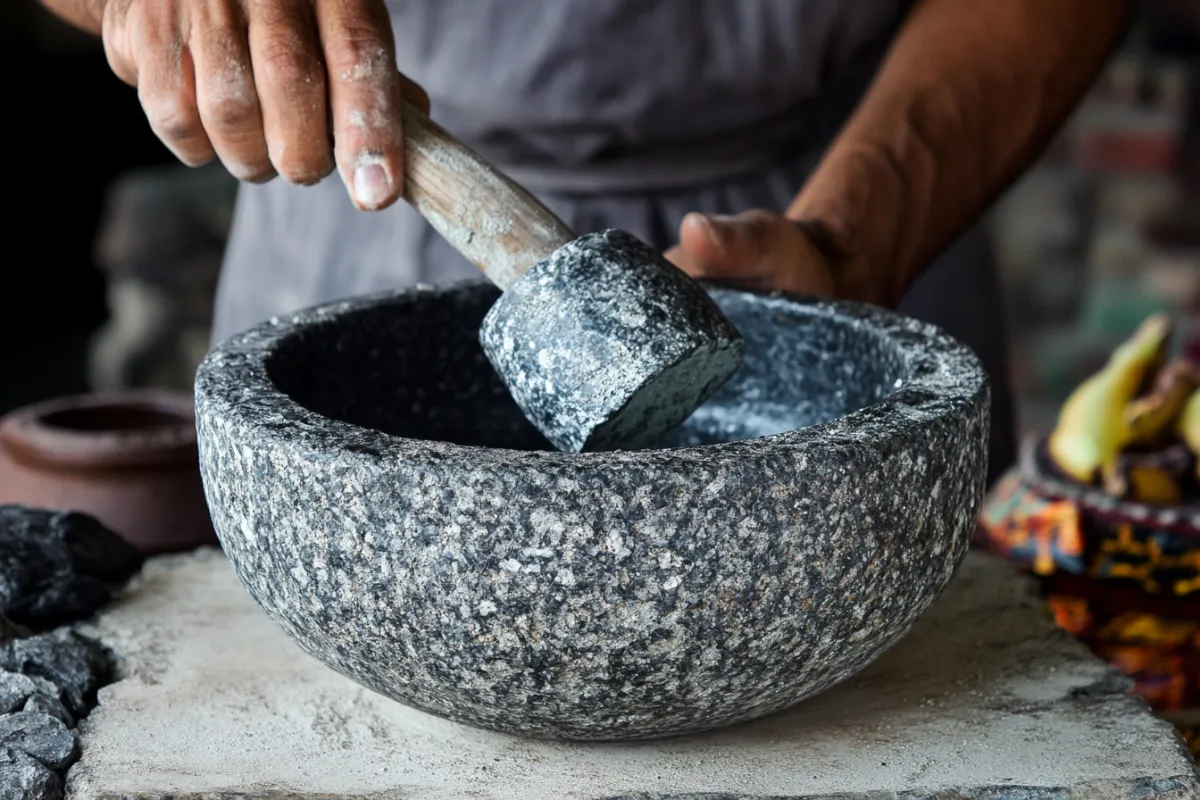Why Is Molcajete So Expensive? A Complete Guide to Understanding the Price of this Traditional Mexican Tool
The molcajete is a symbol of Mexican culinary tradition, used for centuries in kitchens throughout the region. Made from volcanic stone, it serves as both a mortar and a pestle, grinding ingredients like chiles, garlic, and tomatoes into salsas and sauces. However, if you’ve ever tried to purchase an authentic molcajete, you may have noticed that the price tag can be surprisingly high.
This raises the question: Why is a molcajete so expensive? In this article, we will explore the reasons behind the cost, including the quality of the materials, the craftsmanship involved, the cultural significance, and the increasing global demand. We will also examine why molcajetes are preferred by professional chefs and home cooks alike over cheaper imitations made from concrete or other materials.
The Importance of High-Quality Volcanic Stone
One of the primary factors that contribute to the high price of an authentic molcajete is the material from which it is made. Real molcajetes are carved from volcanic rock, specifically basalt, which has unique properties that make it ideal for grinding. Basalt is porous and rough, which helps break down ingredients into fine pastes or powders, releasing the oils and enhancing the flavors of the food.
Why Volcanic Stone Matters
- Porous texture: The rough, porous surface of basalt is key to its ability to grind ingredients properly. Unlike smoother materials, the tiny holes in the stone catch ingredients, allowing them to be ground down more efficiently.
- Heat retention: Basalt retains heat incredibly well, which makes it perfect for serving hot dishes like molcajete mixto. The stone continues to sizzle long after the food has been prepared, keeping it warm and enhancing the dining experience.
- Durability: Volcanic stone is also highly durable, capable of lasting generations if cared for properly. The investment in a high-quality molcajete pays off in the long term, as these tools rarely need to be replaced.
Finding and sourcing the right type of volcanic stone can be a challenge. The stone must come from specific regions where volcanic activity has created the perfect texture for molcajete production. As a result, this adds to the cost of the raw materials. Learn more about why certain kitchen tools require high-quality materials.
The Role of Artisanal Craftsmanship
The second major factor contributing to the price of an authentic molcajete is the craftsmanship involved in its production. Many molcajetes are handmade by skilled artisans, particularly in small villages across Mexico, where families have been perfecting the art of stone carving for generations.
The Hand-Carving Process
Creating a molcajete is a labor-intensive process that can take days, depending on the complexity of the design and the quality of the stone. Each molcajete is carved by hand, using chisels and hammers to shape the bowl and pestle. The artisans must be precise, ensuring that the surface of the molcajete is rough enough to grind ingredients but smooth enough to be functional.
Steps in the crafting process:
- Sourcing the stone: Artisans must first obtain high-quality volcanic stone, often traveling to quarries in remote areas.
- Rough shaping: The initial shaping of the stone involves cutting it down to size and carving out the basic bowl shape.
- Detailing: After the rough shape is completed, the artisan focuses on smoothing the interior and refining the shape.
- Finishing: The final step involves checking the bowl for any imperfections and ensuring it is balanced and ready for use.
The time and skill required to create each molcajete are why authentic, hand-carved pieces tend to cost significantly more than machine-made or mass-produced imitations.
Why Handcrafted Molcajetes Are Worth the Investment
Though you might find cheaper versions of molcajetes made from concrete or other materials, these simply do not offer the same benefits as a handcrafted volcanic stone molcajete. Imitation molcajetes may look the part, but they lack the durability and grinding capability of authentic ones.
The Superiority of Handcrafted Molcajetes
- Effective grinding: The rough volcanic stone used in authentic molcajetes creates the perfect texture for grinding ingredients like chiles, garlic, and tomatoes. Cheaper materials like concrete are too smooth and don’t grind ingredients as effectively.
- Durability: A real molcajete made from volcanic rock can last for decades, while imitations made from other materials tend to crack or wear down after just a few uses.
- Heat retention: Authentic molcajetes are ideal for serving hot dishes, as they can retain heat much longer than their cheaper counterparts.
For serious cooks, the investment in a real molcajete is worthwhile. The tool provides better results and will last much longer than an imitation. Discover more about the benefits of high-quality, traditional tools.
The Cultural Significance of the Molcajete
The molcajete is not just a functional kitchen tool; it also holds deep cultural significance in Mexico. For many families, the molcajete represents a connection to their heritage, and it’s not uncommon for molcajetes to be passed down from one generation to the next as a family heirloom.
Molcajete as a Symbol of Tradition
- Culinary heritage: The molcajete is an essential part of traditional Mexican cooking. Many classic dishes, like guacamole and salsa, are prepared in a molcajete to preserve the authenticity and flavor of the dish.
- Rituals and family gatherings: In some Mexican households, the use of a molcajete is reserved for special occasions, such as family gatherings or celebrations. The act of grinding ingredients by hand is seen as a way of honoring tradition and maintaining a connection to the past.
- Heirloom value: Many families treat their molcajetes as heirlooms, passing them down from generation to generation. This adds to the sentimental value of the tool, making it more than just a kitchen accessory.
Global Demand for Authentic Molcajetes
With the rise of Mexican cuisine around the world, the demand for authentic molcajetes has grown exponentially. As more people discover the benefits of traditional cooking tools, they are willing to pay a premium for a high-quality, handmade molcajete.
Factors Driving Global Demand
- Mexican food’s popularity: The global popularity of Mexican cuisine has led to an increase in demand for authentic cooking tools like the molcajete. From professional chefs to home cooks, many now seek out molcajetes to prepare traditional Mexican dishes.
- Social media influence: Platforms like Instagram and YouTube have popularized Mexican cuisine, making the molcajete a trendy kitchen tool. Food bloggers and influencers often highlight the benefits of using a molcajete, further driving demand.
- Growing appreciation for artisanal goods: In recent years, there has been a shift toward artisanal, handmade products, as consumers increasingly value quality and craftsmanship. This trend has contributed to the rising demand for molcajetes.
Why Volcanic Stone Outperforms Concrete
As previously mentioned, there are cheaper imitations of molcajetes made from materials like concrete. While these may be easier on the wallet, they do not offer the same performance or longevity as volcanic stone molcajetes.
Comparing Volcanic Stone and Concrete Molcajetes
- Texture: Volcanic stone has a rough texture that helps grind ingredients into a fine paste. Concrete molcajetes lack this texture, resulting in uneven grinding and poor flavor extraction.
- Durability: Volcanic stone is incredibly durable and can withstand years of use without cracking or breaking. In contrast, concrete molcajetes are more prone to cracking and wear over time.
- Heat retention: Volcanic stone retains heat far better than concrete, making it ideal for serving hot dishes like molcajete mixto.
For those who value quality and authenticity, an investment in a volcanic stone molcajete is well worth the higher price. Learn more about why traditional materials matter.
How to Identify an Authentic Molcajete
Given the number of imitation molcajetes on the market, it can be difficult to know whether you’re purchasing an authentic volcanic stone molcajete or a cheap knockoff. Here are a few tips to help you identify a genuine molcajete:
- Look for rough textures: Authentic molcajetes have a rough, porous surface. If the stone feels too smooth, it may be made from concrete or another inferior material.
- Check the weight: Real molcajetes are heavy. If the molcajete feels light, it’s likely an imitation.
- Tiny holes: Authentic volcanic stone molcajetes often have small holes or pits in the surface, which are natural formations in the stone.
Caring for Your Molcajete
Once you’ve invested in a high-quality molcajete, it’s important to care for it properly to ensure it lasts for generations.
Tips for Molcajete Care
- Seasoning: Before using a new molcajete, you’ll need to season it by grinding rice or other grains into the stone. This removes any stone dust and smooths the surface.
- Cleaning: After each use, rinse the molcajete with warm water and use a stiff brush to remove any food particles. Avoid using soap, as the stone can absorb it.
- Drying: Allow the molcajete to air-dry completely before storing it. Never store it while damp, as this can lead to cracking or mold growth.
- Long-term maintenance: Over time, the surface of the molcajete may wear down. If this happens, you can re-season the molcajete by grinding rice until the surface is smooth again.
FAQs: Why is Molcajete So Expensive?
1. What makes a molcajete so costly?
Molcajetes are expensive due to the high-quality volcanic stone used in their construction and the skilled craftsmanship required to hand-carve each piece.
2. Is a concrete molcajete a good alternative?
No. Concrete molcajetes do not offer the same grinding capabilities or durability as those made from volcanic stone. They are more prone to cracking and are less effective at grinding ingredients.
3. How do I know if my molcajete is authentic?
Look for a rough texture, heavy weight, and natural pits in the stone. Authentic molcajetes are usually hand-carved and made from volcanic stone.
4. Why do chefs prefer using molcajetes?
Chefs prefer molcajetes because they grind ingredients more finely, enhancing the flavors of dishes like salsa and guacamole. The rough texture of the volcanic stone helps release the oils and flavors of the ingredients.
Conclusion: The Value of Investing in an Authentic Molcajete
Though molcajetes may come with a higher price tag, they offer far more value than their cheaper counterparts. From the volcanic stone that enhances flavor to the artisanal craftsmanship that goes into each piece, a real molcajete is an investment in quality and tradition. Whether you’re a professional chef or a home cook, the molcajete’s ability to grind ingredients effectively and retain heat makes it an essential tool in the kitchen.
By choosing an authentic molcajete, you’re not just buying a kitchen tool—you’re investing in a piece of Mexican culinary heritage that can be passed down for generations. Discover more about traditional cooking tools and why they matter.

